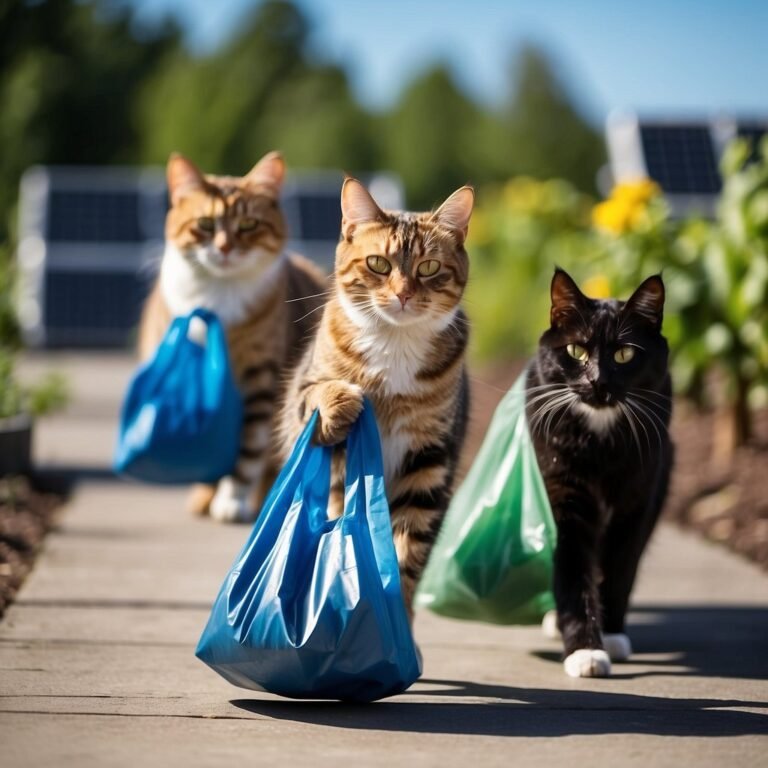Cats Leading the Way in Sustainable Living: Purr-fect Pioneers of Eco-Friendliness 🐾💚

As a cat lover, you’re already well aware of your furry friend’s remarkable agility and instincts.
But have you ever thought about how cats can lead us toward a greener, more sustainable lifestyle? Just like they prowl through our homes and neighborhoods, they’re now tiptoeing through the world of sustainability, teaching us valuable lessons about eco-friendly living.
From choosing sustainable cat food options that support biodiversity and ecosystems, to exploring eco-friendly products, your whiskered companion could be your guide to an environmentally conscious life.

You may not have realized it but selecting the right food for your kitty does more than just keep them healthy—it can also have an impact on the planet.
Sustainable cat food brands are committed to preserving our precious ecosystems and promoting biodiversity.
By purring for ethically sourced meals and snacks, your cat isn’t just concerned with their next treat; they’re advocating for the Earth’s well-being.
Let’s explore how your cat’s diet can contribute to a more sustainable world, and how, with every satisfying purr, you can both feel good about the choices you’re making for a healthier planet. 🌿🐾
Sustainable Diet for Cats
As you pamper your feline friend, considering their diet’s sustainability can make a significant difference for the environment.
From the ingredients to the production process, every choice in your cat’s diet contributes to a more eco-friendly lifestyle.
Organic and Locally Sourced Ingredients
Focusing on organic cat food means fewer pesticides and chemicals, not only in your cat’s diet but also in the soil and water.
Selecting locally sourced ingredients reduces the carbon paw-print associated with transportation.
For example, brands like Castor & Pollux offer organic meat as their primary ingredient, ensuring a reduced environmental impact.
- Benefits:
- Fewer chemicals
- Reduced transportation emissions
Eco-Friendly Meat Choices
Although cats are obligate carnivores and require meat, you can still make eco-friendly choices.
Opt for sustainable cat food brands that prioritize ethically sourced meat, such as poultry over beef, as its production tends to have a lower environmental impact. Acana & Orijen are among the brands that offer premium natural cat food with a commitment to sustainability.
- Sustainable Meat Options:
- Chicken
- Turkey
- Fish (from sustainable sources)
Plant-Based Diet Considerations
While cats do need meat, incorporating some plant-based foods in the form of treats or supplements can be beneficial and sustainable.
However, ensure these are safe for your feline to consume and are not replacing essential meat-based nutrients.
Approach plant-based diet additions with caution, as cats have specific nutritional needs.
- Note: Always consult with a veterinarian before adjusting your cat’s diet.
Through thoughtful choices in your cat’s food, you’re not only ensuring their health 😺 but also taking steps to protect the planet we all call home 🌎.
Environmental Impact of Cats
As a cat lover, you understand the joy these furry friends bring to our lives.
But it’s also important to acknowledge their environmental paw-print, from land and water use to their impact on wildlife.
Land and Water Usage
Cats require specific resources, like meat-based food, which demands a significant amount of land and fresh water to produce.
In fact, the production of cat food is linked to the utilization of large tracts of land, which can lead to habitat destruction in regions such as Asia and Africa. 🐾 Ensuring that your cat’s diet is sourced from sustainable practices can help reduce their environmental impact.
Greenhouse Gas Emissions
The meat industry, which provides the main ingredients for your cat’s diet, contributes to greenhouse gas emissions, including methane. 🌍 These emissions have a compounding effect on global warming.
Opting for cat foods with a lower environmental footprint can be a step towards a more climate-friendly pet care routine.
Wildlife and Biodiversity
Free-ranging domestic cats, including feral cats and stray cats, can pose a threat to biodiversity.
Their hunting behaviors can lead to biodiversity loss, particularly in local ecosystems where they may prey on native wildlife. 🐱 Conservation efforts often involve keeping house cats indoors or in enclosed outdoor spaces to help protect species such as lions, snow leopards, and jaguars, ensuring these magnificent creatures stay part of our world’s diverse tapestry.
Waste Management
Cats are not just adorable companions, but they also inspire us to embrace sustainable living, particularly when it comes to waste management.
Let’s explore some innovative ways to reduce our environmental paw-print with our feline friends.

Cat Litter Alternatives
When it comes to cat litter, there’s more you can do for the planet than you might think.
Consider switching to eco-friendly alternatives like biodegradable litters made from recycled paper, sawdust, or even wheat.
These products not only minimize the use of non-renewable resources but also degrade faster, reducing the load on landfills.
Plus, USDA certified biobased options ensure you’re choosing products that are officially recognized as derived from plants and other renewable materials.
Reducing Plastic Waste
Plastic waste is a purr-sistent problem, but your kitty can help you tackle it! Start with cat products stored with less plastic.
For example, look for litter that comes in recyclable cardboard rather than plastic bags.
Also, for storing all of your cat’s toys and treats, opt for reusable containers or baskets made from sustainable materials.
By reducing plastic waste, you’re not only helping the earth—you’re setting a great example of environmental stewardship for pet owners everywhere.
Responsible Cat Ownership
As a cat lover, you’re not only a pet parent but also a steward of the environment.
Every choice you make in caring for your feline friends impacts their well-being and the world around them.
Let’s explore some key areas of responsible cat ownership to ensure your fur-babies thrive in a sustainable way. 😺🌱
Adoption and Neutering
Adopt, Don’t Shop: Finding your new best friend at an animal shelter significantly reduces the number of homeless cats and supports responsible pet ownership.
Shelters often provide initial healthcare, including vaccinations and spaying or neutering, making adoption a great first step towards responsible cat care.
Neutering to Manage Populations: Neutering your cat is crucial.
This simple procedure not only prevents unexpected litters of kittens but also reduces the number of feral and stray cats struggling to survive on the streets.
A lower stray population leads to less wildlife predation and a better balance with local biodiversity.
Humane Care and TNR Programs
Humane Treatment Equals Happy Cats: Ensure your cat lives a pampered life with regular health checks and a diet reflecting their nutritional needs.
Always opt for products free from harmful chemicals and sourced through ethical means.
TNR Programs Keep Ferals Healthy: Trap-Neuter-Return (TNR) programs are vital for managing feral cat colonies.
By participating in or supporting these programs, you help control the feral population in a humane way.
Caregivers work hard to trap, neuter, and return these cats, often getting them microchipped and vaccinated in the process.
Support for Wildlife Conservation
Your Cat’s Role in the Circle of Life: Keeping your cats indoors or in a secure catio can save countless birds and small mammals, maintaining the delicate balance of local ecosystems.
Conservation-Centric Choices: Support organizations and initiatives dedicated to wildlife conservation.
Making donations, volunteering, and advocating for policies that protect natural habitats all contribute to a brighter future for wildlife and cats alike.
Remember, when you look after your feline friend, you’re also looking out for the many wild critters sharing our planet.
Your choices make a world of difference! 🌍💚🐱
Supporting Sustainable Initiatives
As a cat lover, it’s paw-sible to support our feline friends in a way that also cares for our planet.
This can be achieved through being mindful about certifications and advocating for choices that align with a sustainable future.
Certification and Labeling
When you’re on the prowl for eco-friendly cat food, look for seals like Global Animal Partnership and Certified Humane.
These certifications ensure that the chicken your kitten nibbles on has been raised following rigorous animal welfare standards.
Also, keep an eye out for the Marine Stewardship Council label which guarantees that any seafood in your cat’s feast promotes sustainable fishing practices. 🌎🐟
- Look For:
- Global Animal Partnership
- Certified Humane
- Marine Stewardship Council
Advocacy and Consumer Choices
Embrace your power to advocate for change in the supply chain by choosing brands that prioritize the planet.
When picking out food, litter, or toys for your fur baby, making environmentally-friendly choices goes a long way.
Opt to buy in bulk to reduce packaging waste and search for companies that commit to sustainable practices.
Remember, each purchase is a vote for the kind of world you want your whiskered companions to inherit. 🌱😺
- Actions You Can Take:
- Advocate for eco-friendly practices.
- Choose products with sustainable packaging.
- Buy in bulk whenever possible.

